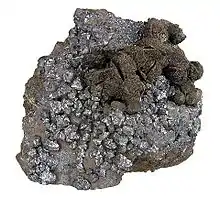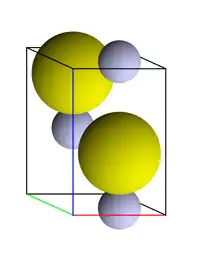| Wurtzite | |
|---|---|
 | |
| General | |
| Category | Sulfide mineral |
| Formula (repeating unit) | (Zn,Fe)S |
| IMA symbol | Wur[1] |
| Strunz classification | 2.CB.45 |
| Dana classification | 02.08.07.01 |
| Crystal system | Hexagonal |
| Crystal class | Dihexagonal pyramidal (6mm) H-M symbol: (6mm) |
| Space group | P63mc |
| Structure | |
| Jmol (3D) | Interactive image |
| Identification | |
| Color | Brownish black, orange brown, reddish brown, black |
| Crystal habit | Radial clusters and colloform crusts and masses. Also as tabular crystals |
| Cleavage | [1120] and [0001] |
| Fracture | Uneven – irregular |
| Mohs scale hardness | 3.5–4 |
| Luster | Resinous, brilliant submetallic on crystal faces |
| Streak | light brown |
| Diaphaneity | Translucent |
| Specific gravity | 4.09 measured, 4.10 calculated |
| Optical properties | Uniaxial (+) |
| Refractive index | nω = 2.356 nε = 2.378 |
| Birefringence | δ = 0.022 |
| Other characteristics | Nonmagnetic, non-radioactive |
| References | [2][3][4] |
Wurtzite is a zinc and iron sulfide mineral with the chemical formula (Zn,Fe)S, a less frequently encountered structural polymorph form of sphalerite. The iron content is variable up to eight percent.[5] It is trimorphous with matraite and sphalerite.[2]
It occurs in hydrothermal deposits associated with sphalerite, pyrite, chalcopyrite, barite and marcasite. It also occurs in low-temperature clay-ironstone concretions.[2]
It was first described in 1861 for an occurrence in the San José Mine, Oruro City, Cercado Province, Oruro Department, Bolivia, and named for French chemist Charles-Adolphe Wurtz.[3] It has widespread distribution. In Europe it is reported from Příbram, Czech Republic; Hesse, Germany; and Liskeard, Cornwall, England. In the US it is reported from Litchfield County, Connecticut; Butte, Silver Bow County, Montana; at Frisco, Beaver County, Utah; and from the Joplin district, Jasper County, Missouri.[2]
Structure

The wurtzite group includes cadmoselite (CdSe), greenockite (CdS), mátraite (ZnS), and rambergite (MnS), in addition to wurtzite.[6]
Its crystal structure is called the wurtzite crystal structure, to which it lends its name. This structure is a member of the hexagonal crystal system and consists of tetrahedrally coordinated zinc and sulfur atoms that are stacked in an ABABABABAB pattern.
The unit cell parameters of wurtzite are (-2H polytype):[7]
See also
References
- ↑ Warr, L.N. (2021). "IMA–CNMNC approved mineral symbols". Mineralogical Magazine. 85 (3): 291–320. Bibcode:2021MinM...85..291W. doi:10.1180/mgm.2021.43. S2CID 235729616.
- 1 2 3 4 Handbook of Mineralogy
- 1 2 Wurtzite at Mindat.org
- ↑ Wurtzite at Webmineral
- ↑ Palache, Charles, Harry Berman & Clifford Frondel (1944), The System of Mineralogy of James Dwight Dana and Edward Salisbury Dana, Yale University 1837-1892, Volume I: Elements, Sulfides, Sulfosalts, Oxides. John Wiley and Sons, Inc., New York. 7th edition, revised and enlarged, pp. 226-228.
- ↑ Wurtzite group on Mindat.org
- ↑ Xu, Yong-Nian; Ching, W. Y. (15 August 1993). "Electronic, optical, and structural properties of some wurtzite crystals". Physical Review B. 48 (7): 4335–4351. Bibcode:1993PhRvB..48.4335X. doi:10.1103/PhysRevB.48.4335. PMID 10008905.